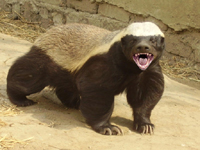

 |

|
 Ratel |
Ratel(Mammal) |
 Ratel Baby |
Ratel HabitsThe ratel is mainly nocturnal. It spends the day below ground and emerges at dusk to hunt through the night. If it is undisturbed the ratel sometimes emerges from its burrow by day as well.
The ratel either digs its own burrow or takes over one belonging to another animal, such as the aardvark. It may also live in a rock crevice or in
a hole among tree roots.
When it digs its own burrow, the ratel creates a tunnel 40 feet long that may be as much as five feet deep.
Despite its small size, the ratel is one of the most ferocious of all animals. Its fierceness is especially evident in the breeding season, when it attacks for no apparent reason. If the ratel is threatened by a person or another animal, its defense is to attack. It grips the intruder in its powerful jaws and maintains its hold.
The ratel is generally solitary by nature, although males and females may occasionally be seen together in pairs. |
Ratel CommunicationRatels use many different forms of communication. One of the major ways they communicate with one another is through an elaborate language that is made up of a variety of vocalizations. They may screech and squeal, utter a rapid trill, and purr when content. During the mating season, females give a twittering call. Vocalizations are also made when the animals feel threatened.
Ratels use musk to mark the borders of their hunting area or territory. This is a chemical form of communication. Musk is a thick, oily yellowish fluid with a very potent odor. It is stored in special scent glands stored at the base of the ratel's tail. The scent is a secret message for other ratels. A ratel may drag its rump on the ground, probably to leave a scent, that informs other ratels of who lives there, how long ago they last visited that spot, and whether they are male or female. Females also use musk to attract their mate. Should another ratel of the same sex wander inside the boundaries, the musk warns the intruder that it is trespassing and is not welcome.
Body language and sounds are also used to communicate when ratels meet each other. Ratels have well-developed senses of sight, hearing, and smell. These senses allow them to be capable predators. |
Ratel BreedingThe ratel, sometimes called the "honey badger," is so secretive that little is known about its breeding habits. One or two young are born after a gestation period of six to seven months. Birth takes place in a burrow, rock crevice, or hollow tree. Researchers believe that the male takes no part in raising the young. |
Ratel Food & FeedingThe ratel eats almost anything it finds. Its varied diet includes small mammals and birds, as well as snakes, fish, scorpions, termites and other insects. It also eats eggs, berries, fruit, tubers, roots, and honeyeven the deadly mamba snake.
When it is searching for food, the ratel digs into the burrows of meerkats, ground squirrels, rats, and mice, killing and eating the occupants. It also kills domestic sheep and chickens. |
Ratel Key Facts |
| Size |
| Height: 12 inches to shoulder. Length: Up to 3 feet including tail |
| Weight: 18-35 pounds. Male heavier than female |
| Breeding |
| Sexual maturity: 3 or 4 months of age |
| Mating: July or early August |
| Gestation: 6-7 months |
| Number of young: 1-2 young |
| Lifestyle |
| Habit: Nocturnal, usually solitary |
| Diet: Birds, fish, reptiles, carrion, roots, tubers, fruits, and berries |
| Lifespan: 25 years in captivity |
DID YOU KNOW?
|
CAN'T FIND WHAT YOU'RE LOOKING FOR? CLICK HERE!!!